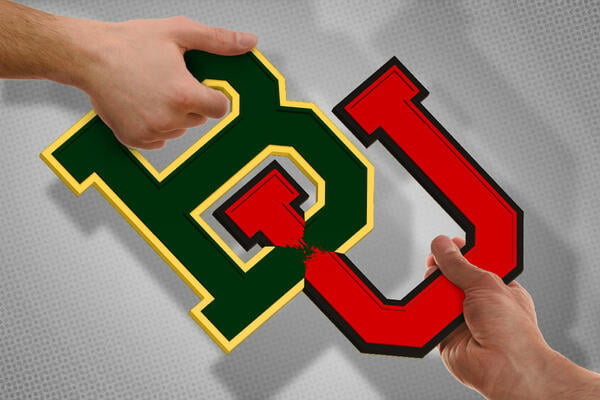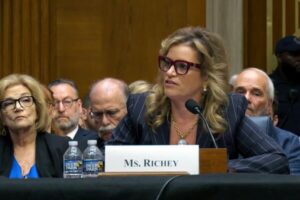
Universities Battle Over Brands
When Baylor University sued Boston University last week over a similar logo, it made national headlines as the two institutions grappled over how their shared initials may be displayed.
Baylor, located in Texas, alleged in its lawsuit that Boston U, nearly 2,000 miles away in Massachusetts, violated a 1988 agreement on the use of its interlocking BU logo. Baylor argued that Boston’s use of the interlocking BU logo is “likely to cause confusion, to cause mistake, or to deceive consumers and potential consumers.” The two logos, while in different colors, are visually similar, and many of their products are sold on the same websites, the lawsuit noted.
But the legal tug-of-war over who gets to use the BU logo is just one of many recent brand battles across higher education, with universities suing one another and popular entertainment companies and taking action against scammers who have used their trademarks for nefarious reasons. Universities have also put middle schools and small local businesses on notice.
Baylor vs. Boston
Baylor’s lawsuit notes that Boston began using the interlocking BU logo in 2018, some 30 years after agreeing not to. The Texas university pressed Boston on the matter in 2021 but alleges that not only did the other BU not drop the contested logo, but it also expanded its use to more merchandise.
Josh Gerben, a trademark attorney at Gerben IP, believes Baylor has a strong case, though he noted Boston has yet to file its legal response to the complaint, which shed light on its rationale for using the logo. There are also good reasons for filing the case, he argued, namely to prevent the trademark from being diluted and losing value. Essentially, if Boston can use the logo without pushback, others are more likely to do the same.
“It’s not only about this case—it’s about this idea that you have to police your trademark to maintain the zone of protection around your mark and be able to enforce it in other situations,” Gerben said.
Universities often make significant money licensing their name and logo for branded merchandise, he added, which they want to protect.
But some observers have questioned why the brand battle is even necessary, with critics skeptical of any potential confusion between the two universities given their distance and different national profiles.
Even so, Baylor is pressing forward with the lawsuit.
“A university has a responsibility and a right to defend its federally registered trademarks,” Baylor spokesperson Lori Fogelman wrote in an emailed statement to Inside Higher Ed.
Boston University officials declined to comment.
College Brand Battles
Baylor joins multiple universities that have sued other institutions over trademark concerns.
Carol Keese, vice president for communications and chief marketing officer at the University of Oregon, compared such lawsuits to Fortune 500 companies and others protecting their brands. She argued university brands represent their thought leadership, research portfolios and athletic programs and offer a way for individuals to connect over a shared passion for an institution.
“There’s no greater measure of affinity than the degree to which your alumni or your fans or your aspiring students and families want to put your institution’s name on their bodies as a form of branded merchandise. That’s a huge measure of affinity, of loyalty, of emotional connection,” Keese said.
And it isn’t just major national universities fighting over who gets to use a logo.
Last year, Drake University sued nearby Des Moines Area Community College over the college’s rebrand, which incorporated a large letter “D” into DMACC’s new logo. Drake accused the community college of trademark infringement and unfair competition, among other claims. DMACC lawyers fired back with a defamation suit against Drake that a federal judge dismissed earlier this year.
A judge has blocked DMACC from using the logo for now, but the legal fight continues.
Other cases have involved similar names.
In 2023, the University of Rochester in New York sued Rochester University in Michigan for trademark infringement. The university in New York alleged the Michigan institution had damaged UR’s brand, confused prospective students and cashed in on its reputation.
The Michigan institution rebranded as Rochester Christian University less than a year later, announcing that it had reached a settlement out of court. The case was voluntarily dismissed.
Colleges vs. Corporations
Many of higher education’s trademark battles are with outside entities.
For instance, earlier this month Columbia Sportswear filed a lawsuit against Columbia University, with the apparel company accusing the Ivy League institution of breaching a 2023 contract between the two entities, trademark infringement and unfair competition. That lawsuit is ongoing.
Pepperdine University sued Netflix and Warner Bros. in February, accusing the entertainment companies of trademark infringement. Pepperdine alleged that the companies misappropriated the trademarked name of its athletics team (Waves), its colors and more for a series titled Running Point about a fictional basketball team with the same moniker and other similarities. That legal battle is ongoing.
University legal teams have also gone after scammers behind fake college websites. A recent investigation by Inside Higher Ed uncovered a network of nearly 40 fake institutions, some with names similar to real universities’. Several universities have taken action in those cases, filing domain disputes with the World Intellectual Property Organization in an effort to seize ownership of the fraudulent sites and take them off-line.
Other brand-related concerns haven’t risen to the level of lawsuits but provoked strong pushback, such as when Duke University blasted HBO for a scene in the hit series The White Lotus in which a character (a proud Duke alum) contemplated suicide while wearing a university T-shirt. Duke told media outlets that it never approved the use of its trademark.
Backlash
Sometimes universities manage to protect their trademark, but at a cost to their reputation.
Last year the University of Cincinnati sent Cheatham Middle School in Tennessee a cease-and-desist letter for using UC’s Bearcat mascot, a similar logo and other signage.
Officials at the middle school, which had used the contested logo and name for decades, said they tried to strike a compromise by adopting new imagery but keeping the Bearcats moniker (which is used at multiple K–12 schools across the country). But Cincinnati allegedly denied that request.
Critics accused Cincinnati of being overly sensitive and unnecessarily litigious, arguing that no one was going to confuse a middle school in Tennessee with a university in Ohio. Ultimately, Cheatham Middle School rebranded as the Musketeers, adopting the same name and a similar logo to the one used by Xavier University, Cincinnati’s cross-town athletic rival.
Cincinnati spokesperson M. B. Reilly defended the move in an email to Inside Higher Ed, writing that the middle school “appropriated UC’s identity in a variety of ways” beyond the name and accused CMS officials of posting “inaccurate information” as it sought to resolve the issue.
“Overall, we appreciate interest in using UC’s iconic trademarks, which are recognized both nationally and globally. But we ask that entities seek permission to do so,” Reilly wrote.
In 2012 the University of Alabama sent a cease and desist letter to Mary’s Cakes & Pastries, a local bakery, that sold cookies with houndstooth-pattern icing, or with footballs and elephants or a big “A.” The bakery also made special-order cakes decorated with Crimson Tide themes.
The legal action prompted outrage and ridicule, with one local telling The Tuscaloosa News that the university was “acting like a greedy shrew defending a girlie Script ‘A’” in the brand battle. Alabama soon backed off amid the backlash, and a university official called the bakery to apologize.
Although the universities in those cases appeared to be on solid legal footing, Keese suggests there is room for compromise and that institutions should manage their brands in ways that allow for flexibility.
“I think you need to take a measured strategic approach that understands where your brand is most at risk, where you need to lean in to protect it and grow it, and where you can have a conversation with an organization, or make a deliberate exception for a local bakery shop,” Keese said. “That’s the kind of relationship management that’s also part of your brand.”
Source link



